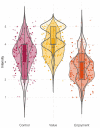Assessing psychological variables on mobile devices: an introduction to the experience sampling app ESM-Quest
- PMID: 38343893
- PMCID: PMC10853368
- DOI: 10.3389/fpsyg.2023.1271422
Assessing psychological variables on mobile devices: an introduction to the experience sampling app ESM-Quest
Abstract
The use of the Experience Sampling Method (ESM), which involves repeated assessments in people's daily lives, has increased in popularity in psychology and associated disciplines in recent years. A rather challenging aspect of ESM is its technical implementation. In this paper, after briefly introducing the history of ESM and the main reasons for its current popularity, we outline the ESM-Quest experience sampling app which is currently being developed at the University of Vienna. ESM-Quest runs on different operating systems, specifically on mobile devices such as smartphones and tablets running either iOS or Android. An internet connection is not necessary during the assessment. Compared to most other ESM apps, ESM-Quest allows event-based random sampling, which is very helpful when assessments need to be collected within specific situations. Currently, ESM-Quest is being utilized at the University of Vienna and will be made available for research groups worldwide upon request. We introduce the technical aspects of ESM-Quest and provide examples of analyses on ESM data collected through this app, such as examining fluctuations in constructs within individuals. Finally, we outline potential next steps in ESM research.
Keywords: ESM-Quest; assessment; experience sampling method; psychological variables; real-time data; state; trait.
Copyright © 2024 Goetz, Steiner, Graf, Stempfer, Ristl, Rupprecht, Donath, Botes and Nikitin.
Conflict of interest statement
The authors declare that the research was conducted in the absence of any commercial or financial relationships that could be construed as a potential conflict of interest.
Figures






Similar articles
-
Combining Experience Sampling and Mobile Sensing for Digital Phenotyping With m-Path Sense: Performance Study.JMIR Form Res. 2023 Mar 7;7:e43296. doi: 10.2196/43296. JMIR Form Res. 2023. PMID: 36881444 Free PMC article.
-
Experience Sampling as a dietary assessment method: a scoping review towards implementation.Int J Behav Nutr Phys Act. 2024 Aug 27;21(1):94. doi: 10.1186/s12966-024-01643-1. Int J Behav Nutr Phys Act. 2024. PMID: 39192362 Free PMC article.
-
Usability of the Experience Sampling Method in Specialized Mental Health Care: Pilot Evaluation Study.JMIR Form Res. 2023 Nov 21;7:e48821. doi: 10.2196/48821. JMIR Form Res. 2023. PMID: 37988137 Free PMC article.
-
Feasibility and Acceptability of Using a Mobile Phone App for Characterizing Auditory Verbal Hallucinations in Adolescents With Early-Onset Psychosis: Exploratory Study.JMIR Form Res. 2019 May 14;3(2):e13882. doi: 10.2196/13882. JMIR Form Res. 2019. PMID: 31094321 Free PMC article.
-
Tracking Infant Development With a Smartphone: A Practical Guide to the Experience Sampling Method.Front Psychol. 2021 Dec 6;12:703743. doi: 10.3389/fpsyg.2021.703743. eCollection 2021. Front Psychol. 2021. PMID: 35035365 Free PMC article. Review.
Cited by
-
How Similar Are Students' Aggregated State Emotions to Their Self-Reported Trait Emotions? Results from a Measurement Burst Design Across Three School Years.Educ Psychol Rev. 2025;37(1):26. doi: 10.1007/s10648-025-09995-1. Epub 2025 Mar 13. Educ Psychol Rev. 2025. PMID: 40092058 Free PMC article.
-
Generativity across adulthood: how nature exposure and future time perspective shape motivation for social and ecological engagement.Aust J Psychol. 2024 Nov 18;76(1):2428306. doi: 10.1080/00049530.2024.2428306. eCollection 2024. Aust J Psychol. 2024. PMID: 40666646 Free PMC article.
References
-
- Asseburg R., Frey A. (2013). Too hard, too easy, or just right? The relationship between effort or boredom and ability-difficulty fit. Psychol. Test Assess. Model. 55, 92–104.
-
- Beal D. J. (2015). ESM 2.0: state of the art and future potential of experience sampling methods in organizational research. Annu. Rev. Organ. Psych. Organ. Behav. 2, 383–407. doi: 10.1146/annurev-orgpsych-032414-111335 - DOI
-
- Bevans G. E. (1913). How workingmen spend their time. New York: Columbia University Press.
-
- Consolvo S., Walker M. (2003). Using the experience sampling method to evaluate ubicomp applications. IEEE Perv. Comp. 2, 24–31. doi: 10.1109/MPRV.2003.1203750 - DOI
LinkOut - more resources
Full Text Sources

